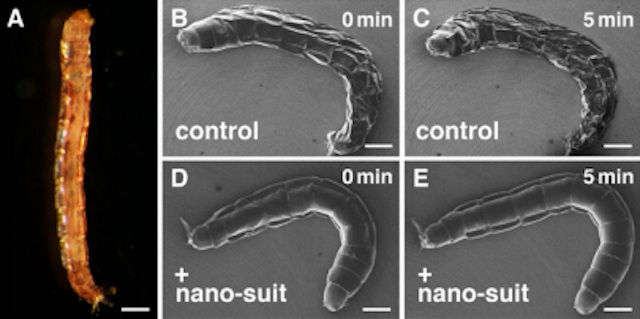Tiny Space Suits Let Insect Larvae Survive in a Vacuum

There aren’t much better ways to get a close look at something than by using a scanning electron microscope (SEM), but the microscopes have one major flaw when it comes to studying biology: They only work in a vacuum, while living creatures, well, don’t work in a vacuum, unless you count “quickly shriveling up and dying” as work. A team of scientists in Japan, though, may have found a way around that obstacle. By treating insect larvae with electron beams, they can build “nanosuits” that can keep the animals alive in a vacuum for up to an hour.
To create the nanosuits — essentially homegrown, tiny space suits that enclose the larvae and protect it from the hazards of the vacuum, namely dehydration and collapsing in on itself — the team at the Hamamatsu University School of Medicine bombarded insect larvae like immature midges, mosquitoes, and fruit flies with either electron beams, plasma radiation, or both, depending on the experiment.
Bombarding the baby bugs with the correct mixture of radiation caused the goo that surrounds the larvae — extracellular substance, or ECS — to polymerize, turning itself into a sort of plastic casing around the larvae. Just a fraction of the thickness of a human hair, the polymer case is flexible enough that the creature can move around in it, but tough enough to help it survive in the high vacuum that SEMs operate in. After observing that a so-called nanosuit of polymerized ECS helped fruit fly larvae stay alive for up to an hour, researchers turned to the larvae of other animals, like midges, that are coated in ECS, and had similar results. They even managed to create nanosuits for mosquito larvae, which don’t have an ECS coating, by covering them in the detergent chemical Tween 20 and then exposing them to plasma radiation.
By preventing the vacuum from instantly killing larvae when they go under the microscope, these nanosuits could be the key to getting a more accurate look at the innermost workings of living creatures. More than that, though, electrons and plasma particles, which exist naturally in space, could one day help to form ECS nanosuits for organisms that could let them survive in the depths of space — for a little while, anyway. You can read the full study for free in the Proceedings of the National Academy of Sciences.
(via PNAS)
- Think you’ve got what it takes to wear a NASA space suit? Find out
- Your space suit isn’t clean until it’s laser clean
- What we’re really interested in, though, is zebra suits
Have a tip we should know? tips@themarysue.com